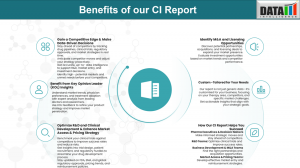Retinitis Pigmentosa Therapeutics Enter New Era as Gene-Agnostic & Intravitreal Therapies Redefine Competitive Landscape
Retinitis Pigmentosa therapies evolve beyond gene-specific fixes with gene-agnostic, intravitreal, and optogenetic advances reshaping the treatment landscape.
Download Free CI Sample Report: https://www.datamintelligence.com/strategic-insights/sample/retinitis-pigmentosa-rp
Disease Burden and Market Need
RP is the most prevalent inherited retinal dystrophy, affecting over two million people globally. Characterized by early-onset degeneration of rod cells, followed by cone cell deterioration, the disease leads to night blindness, tunnel vision, and eventually complete sight loss. With more than 100 implicated genes, RP remains genetically diverse and highly underserved in terms of therapeutic options.
To date, LUXTURNA (voretigene neparvovec) is the only FDA-approved gene therapy for RP—but it applies to a narrow slice of the patient population (~1–6%) with RPE65 mutations. For the majority, there is still no disease-modifying treatment, leaving a substantial unmet need.
Pipeline Innovations and Strategic Positioning
The RP pipeline is now populated by a wide array of candidates targeting diverse genetic forms and stages of disease. Leading the charge are late-stage gene therapies such as Botaretigene sparoparvovec (Janssen) for X-linked RP and OCU400 (Ocugen), which uniquely takes a gene-agnostic approach by using modifier gene NR2E3.
Other notable candidates include:
- Sonpiretigene Isteparvovec (Nanoscope): A mutation-independent optogenetic therapy delivered intravitreally, ideal for late-stage patients.
- Ultevursen (Laboratoires Théa/Sepul Bio): An antisense oligonucleotide (ASO) therapy targeting USH2A exon 13 mutations, also delivered intravitreally.
- jCell (jCyte): A cell therapy using allogeneic retinal progenitor cells, designed for patients regardless of genetic background.
- KIO-301 (Kiora Pharmaceuticals): A photoswitch small molecule aimed at reactivating degenerated photoreceptors in low-vision patients.
These therapies collectively represent a dramatic shift in RP treatment: from precision medicine tied to a single mutation to scalable, mutation-independent approaches with non-invasive delivery methods.
Intravitreal Delivery: A Competitive Edge
The evolution from sub-retinal to intravitreal injection marks a practical turning point. Sub-retinal gene therapies like LUXTURNA require surgical intervention, limiting widespread adoption. Intravitreal options like MCO-010, Ultevursen, and jCell are administered in-office, significantly lowering barriers to treatment and aligning with existing ophthalmic care infrastructure.
Book Your CI Consultation Call: https://www.datamintelligence.com/strategic-insights/ci/retinitis-pigmentosa-rp
Target Opportunity Profile (TOP)
- To compete effectively, new RP therapies must demonstrate:
- Mutation independence or broader genetic applicability
- Practical, minimally invasive delivery (intravitreal preferred)
- Efficacy in mid- to late-stage patients
- Cost-effective scalability
- Long-term safety and durability of effect
- Regulatory acceleration through ODD, RMAT, or PRIME designations
The Target Opportunity Profile (TOP) developed in the report underscores that first-mover therapies offering these advantages could dominate large, currently untapped patient segments.
Strategic Landscape: Key Players and Opportunities
The competitive landscape is heating up. High-intensity competition exists in X-linked RP gene therapies (RPGR), where multiple programs vie for the first approved product. In contrast, optogenetics, RNA therapies, and cell-based treatments remain less crowded, offering a strategic entry point for companies seeking differentiation.
Companies Leading the Charge Include:
- Janssen (Botaretigene sparoparvovec) – poised for regulatory milestones in X-linked RP
- Ocugen (OCU400) – a gene-agnostic platform with RMAT designation
- Nanoscope Therapeutics (MCO-010) – optogenetic therapy targeting late-stage degeneration
- jCyte (jCell) – a scalable cell therapy nearing Phase III trials
- Laboratoires Théa/Sepul Bio (Ultevursen) – first-in-class ASO for USH2A mutations
Conclusion
The Retinitis Pigmentosa therapeutic pipeline is no longer defined by narrow genetic fixes. Instead, it is being reshaped by multimodal innovation, broader patient targeting, and user-friendly delivery systems. With over 2 million affected globally and limited approved options, RP represents one of the most attractive yet underpenetrated markets in rare ophthalmology. Companies that combine clinical efficacy with accessibility, mutation breadth, and scalable delivery will lead the next wave of market disruption.
Read More Related CI RDs:
1. Chronic Inflammatory Demyelinating Polyneuropathy | CI Insights
2. Inflammatory Bowel Disease | Competitive Intelligence
Sai Kumar
DataM Intelligence 4market Research LLP
+1 877-441-4866
email us here
Visit us on social media:
LinkedIn
X
Legal Disclaimer:
EIN Presswire provides this news content "as is" without warranty of any kind. We do not accept any responsibility or liability for the accuracy, content, images, videos, licenses, completeness, legality, or reliability of the information contained in this article. If you have any complaints or copyright issues related to this article, kindly contact the author above.
Casa Youth Shelter’s Bootstrap Ball Achieves Record Success
Norman Grant Recognized as Chairman’s Level Advisor by Commonwealth Financial Network®
AO Scan Global at the Forefront of the Frequency Wellness Revolution in 2025
Kalendarium
Więcej ważnych informacji
 Jedynka Newserii
Jedynka Newserii

 Jedynka Newserii
Jedynka Newserii

Polityka

Prof. Kołodko: Elon Musk stracił na roli doradcy Donalda Trumpa. Można mieć zastrzeżenia do rezultatów jego misji
Po pół roku szefowania Departamentowi Efektywności Rządowej (DOGE), którego celem było znalezienie oszczędności kosztem cięć personalnych w administracji federalnej, Elon Musk zdecydował się na rezygnację z politycznej kariery i powrót do świata biznesu. Jego Tesla nie może zaliczyć I kwartału br. do udanych. Zdaniem byłego ministra finansów prof. Grzegorza Kołodki do rezultatów pracy Muska można mieć wiele zastrzeżeń, choć część założeń udało mu się wykonać.
Farmacja
Polacy leczą samodzielnie ponad połowę lekkich dolegliwości zdrowotnych. Jesteśmy liderem UE

Szacuje się, że w Unii Europejskiej codziennie występuje ok. 3,3 mln przypadków lekkich dolegliwości. Gdyby każdy pacjent zgłaszał się z nimi do lekarza, potrzebnych byłoby dodatkowo 120 tys. lekarzy pierwszego kontaktu lub obecni lekarze musieliby pracować dodatkowe 144 minuty dziennie. Polska pod względem samoleczenia, ze wskaźnikiem na poziomie 55 proc., plasuje się w czołówce UE. – Samodzielne leczenie to nie tylko kwestia wygody pacjenta, ale przede wszystkim realne odciążenie systemu ochrony zdrowia – przekonuje Ewa Królikowska z PASMI.
Ochrona środowiska
Naukowcy wzywają do większej ochrony oceanów. Przestrzegają przed groźnym w skutkach przełowieniem stad

Bioróżnorodność oceanów jest zagrożona i musimy zrobić wszystko, aby ją chronić – biją na alarm naukowcy z całego świata. Badani przez organizację Marine Stewardship Council wskazują, że przyczyniają się do tego przede wszystkim zmiany klimatyczne i przełowienie. W związku z przypadającym 8 czerwca Światowym Dniem Oceanów eksperci MSC zachęcają do wspólnej edukacji na temat tego, jakie działania może podjąć każdy z nas na rzecz ochrony morskiego ekosystemu.
Partner serwisu
Szkolenia

Akademia Newserii
Akademia Newserii to projekt, w ramach którego najlepsi polscy dziennikarze biznesowi, giełdowi oraz lifestylowi, a także szkoleniowcy z wieloletnim doświadczeniem dzielą się swoją wiedzą nt. pracy z mediami.





![Rusza ważna inwestycja w Ustce. Nowa baza będzie zapleczem serwisowym dla morskich farm wiatrowych [AUDIO]](https://www.newseria.pl/files/1097841585/dsc-4621small_1,w_85,_small.jpg)



.gif)

 |
| |
| |
|